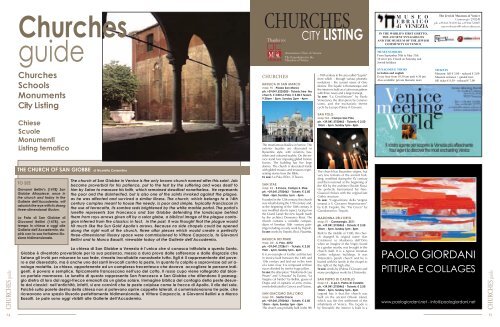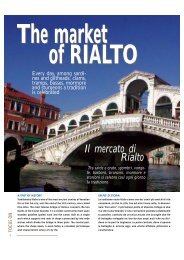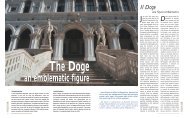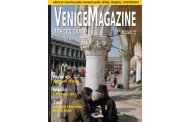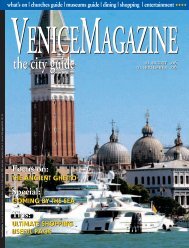venice magazine 43
venice magazine 43
venice magazine 43
You also want an ePaper? Increase the reach of your titles
YUMPU automatically turns print PDFs into web optimized ePapers that Google loves.
Museums<br />
guide<br />
Museo Diocesano di Arte Sacra<br />
until June 30<br />
Museums<br />
Theatres<br />
Galleries<br />
Exhibitions<br />
City Listing<br />
MUSEUMS guide<br />
8<br />
Musei<br />
Teatri<br />
Gallerie<br />
Esposizioni<br />
Listing tematico<br />
FONDAZIONE QUERINI STAMPALIA<br />
FONDAZIONE QUERINI STAMPALIA<br />
Until March 11<br />
Closing day: Monday<br />
Info +39.041.2711411<br />
MARCO POLO: ACCOUNT OF AN EXTRAORDINARY VOYAGE<br />
The exhibition displays over one-hundred drawings by Guido Fuga and Lele Vinello, long-time<br />
partners of Hugo Pratt, featured in the book „Marco Polo: Narration of an extraordinary voyage“<br />
(Supernova, 2006). Rather than the famous Venetian wayfarer himself, it is the very characters<br />
depicted who act as witnesses to his passage through Asia and who narrate his adventures and<br />
evoke the remote lands he visited: the Gobi desert, Ceylon, Byzantium...or the Battle of Curzola.<br />
The voices of the protagonists of one of the most extraordinary voyages in history take on a new<br />
form and life thanks to a complete mosaic of words and images which traces the biography of<br />
eight-century-old Corto Maltese and around him conjures up exotic impressions, sceneries of faraway<br />
lands, so dearly loved by Hugo Pratt. Some characters include the pilgrim and the templar,<br />
the galley commander and the caravaneer, Pope Gregory X and the Mongolian Emperor Kubla<br />
Khan and Rustichello da Pisa of course, who gave the “Milione” its literary form.<br />
MARCO POLO: TESTIMONIANZE DI UN VIAGGIO STRAORDINARIO<br />
In mostra gli oltre cento disegni eseguiti da Guido Fuga e Lele Vinello, collaboratori storici di Hugo<br />
Pratt, per il volume “Marco Polo. Testimonianze di un viaggio straordinario” (Supernova, 2006). Più<br />
che il famosissimo viaggiatore veneziano, pare siano piuttosto i vari personaggi in essi rappresentati,<br />
testimoni del suo passaggio nelle terre dell’Asia, a raccontarci le sue avventure e a evocare<br />
le remote lande da lui visitate: il deserto di Gobi, Ceylon, Bisanzio…o la battaglia di Curzola. Le<br />
voci dei protagonisti di uno dei viaggi più straordinari della storia riprendono forma e vita grazie a un vero e proprio mosaico di parole<br />
e immagini che traccia la biografia di un Corto Maltese di otto secoli fa e raccoglie intorno a lui quelle suggestioni esotiche, quegli<br />
scenari di terre lontane tanto cari a Pratt. Ed ecco il pellegrino e il templare, il comandante di galea e il carovaniere, papa Gregorio<br />
X e l’imperatore dei Mongoli Kubilai Khan e naturalmente Rustichello da Pisa, che diede forma letteraria al “Milione”.<br />
OFFICINA DURER<br />
long with Rembrandt and Goya, Albrecht Dürer (1471-1528)<br />
is one of the all-time greatest exponents of the art of engraving.<br />
A true Lutheran, according to whom the progress of technical<br />
tools is granted to the wit of man directly by God, he most likely prefigured<br />
the Calvinist idea according to which each man must earn his<br />
“elected” status through his practical deeds, under the awareness of a<br />
destiny determined invariably by God. Like Luther, who felt the necessity<br />
of a religious reform, he too became the promoter of an equally<br />
important reform: that of Northern art, taking inspiration especially<br />
from his trips to Italy, which molded him into a “learned” artist. Two<br />
multi-leg itineraries, in 1494-95 the first and, after 11 years the second,<br />
led him to Venice, Padua, Mantua, Rome, Bologna and familiarized<br />
him with, among the other masterpieces, those of Mantegna, Bellini<br />
and Piero della Francesca. He understood that Humanism and<br />
Reformation could complete one another under the co-existence of formal<br />
rigour and aesthetic purity, of scientific dogma and religious devotion.<br />
Northern Art – following the path set by him for the birth of a<br />
similar renaissance culture – would have redressed the gap thanks to<br />
the union of science and art. His extraordinary artistic production helped<br />
surpass the idea of a work of art created not just exclusively by similitude<br />
to an archetype but by the relationship between the artist and<br />
the world surrounding him, which is original, free and superior.<br />
Shifting attention from the role of craftsmanship to that of approach, he<br />
transformed his workshop into an actual “research lab” : an workshop<br />
of ideas, experiments, technical elaboration, the center of which, like in<br />
Leonardo’s and Michelangelo’s case, was no longer the result alone but<br />
rather the project itself. “Dürer Workshop” is the actual title of the exhibition<br />
which, at the Museo Diocesano until June 30th 2007, will<br />
display one-hundred among the most important engravings and woodcuts<br />
of the great artist from Nurnberg – the Apocalypse (1498), The<br />
Great (1511) and the Little Passion (1509-11), Knight, Death, and the<br />
Devil (1513), Melencolia I (1514) – enriched and made unique by his<br />
important studies on the human body and on perspective.<br />
Con Rembrandt e Goya, Albrecht Dürer (1471-1528) è uno dei<br />
massimi esponenti di tutti i tempi dell’arte incisoria. Luterano<br />
convinto - secondo il quale il progresso dei mezzi tecnici è concesso<br />
al “genio” umano direttamente da Dio - egli anticipò tuttavia<br />
forse più le idee calviniste, secondo cui ogni uomo deve guadagnare<br />
lo status “eletto” col proprio operare pratico, nella consapevolezza di<br />
un destino comunque determinato da Dio. Come Lutero, che avvertì<br />
la necessità di una riforma religiosa, anch’egli si fece motore di un’altrettanto<br />
importante riforma: quella dell’arte nordica, traendo ispirazione<br />
soprattutto dai suoi viaggi in Italia, che lo plasmarono facendone<br />
un artista “erudito”. Due itinerari a più tappe, nel 1494-95 il primo<br />
e, a distanza di undici anni il secondo, lo condussero a Venezia,<br />
Padova, Mantova, Roma, Bologna e gli fecero conoscere, fra le altre,<br />
le opere di Mantegna, Bellini e Piero della Francesca. Intuì che<br />
Umanesimo e Riforma avrebbero potuto completarsi, nella coesistenza<br />
di rigore formale e purezza estetica, di dogma scientifico e<br />
devozione religiosa. L’arte nordica – mediante il solco da lui tracciato<br />
per la nascita anche qui di una cultura rinascimentale - avrebbe colmato<br />
la distanza grazie al connubio arte-scienza. La sua straordinaria<br />
attività artistica contribuì a superare l’idea di un’opera d’arte creata<br />
non più esclusivamente per similitudine di un archetipo, bensì dalla<br />
relazione tra l’artista e il mondo che lo circonda, poiché originale, libera<br />
e superiore. Spostando l’attenzione dalla prassi artigianale all’attitudine,<br />
egli trasformò la sua bottega in un vero e proprio “laboratorio<br />
di ricerca”: un’officina di idee, sperimentazioni, elaborazioni tecniche,<br />
al cui centro, come per Leonardo e Michelangelo, non era più solo il<br />
risultato, ma il “progetto”. Proprio “Officina Dürer” è il titolo della<br />
mostra che, fino al 30 giugno 2007, espone al Museo Diocesano cento<br />
tra le più importanti e famose incisioni e xilografie del grande artista<br />
di Norimberga - l’Apocalisse (1498), la Grande (1511) e la Piccola<br />
Passione xilografica (1509-11), Il Cavaliere, la Morte, il Diavolo<br />
(1513), la Melencolia I (1514) - arricchite e rese uniche dai suoi importanti<br />
studi su corpo umano e prospettiva.<br />
MUSEUMS guide<br />
9


